博文
Fluorogenic Probe for Hepatocellular Carcer Chemotherapy
|
Rational Design of a Highly Selective Near-Infrared Two-Photon Fluorogenic Probe for Imaging Orthotopic Hepatocellular Carcinoma Chemotherapy
Dr. Xiaofeng Wu[+], Dr. Rui Wang【王锐】[+], Sujie Qi, Dr. Nahyun Kwon, Jingjing Han, Heejeong Kim, Dr. Haidong Li, Prof. Dr. Fabiao Yu【于法标】*, Prof. Dr. Juyoung Yoon*
Dr. Xiaofeng Wu, Dr. Rui Wang,These authors contributed equally to this work.共同第一作者
Dr. X. Wu,[+] S. Qi, Dr. N. Kwon, J. Han, H. Kim, Dr. H. Li, Prof. Dr. J. Yoon Department of Chemistry and Nanoscience, Ewha Womans University Seoul 03706 (Republic of Korea) E-Mail: jyoon@ewha.ac.kr
Dr. R. Wang,[+] Prof. Dr. F. Yu Key Laboratory of Emergency and Trauma, Ministry of Education, Key
Laboratory of Hainan Trauma and Disaster Rescue, The First Affiliated Hospital of Hainan Medical University, Institute of Functional Materials and Molecular Imaging, College of Emergency and Trauma, Hainan Medical University Haikou 571199 (China)
E-Mail: yufabiao@hainmc.edu.cn
https://onlinelibrary.wiley.com/doi/10.1002/ange.202101190
https://doi.org/10.1002/ange.202101190
Abstract
Keywords: activatable probes• analytical methods • specific substrate • fluorogenic imaging• orthotopic hepatocellular carcinoma
In this report, we show that a carbamate as recognition unit has an excellent selectivity for a hepatocellular carcinoma chemotherapy (HCC)-related biomarker (carboxylesterase, CE) without interference from other hydrolases. We developed a near-infrared two-photon fluorescent probe with high selectivity and strong fluorescence signals towards CE activity, enabling it to successfully monitor CE activity for evaluating HCC chemotherapy in vivo.

Abstract
Selective fluorescence imaging of biomarkers in vivo and in situ for evaluating orthotopic hepatocellular carcinoma (HCC) chemotherapy remains a great challenge due to current imaging agents suffering from the potential interferences of other hydrolases. Herein, we observed that carbamate unit showed a high selectivity toward the HCC-related biomarker carboxylesterase (CE) for evaluation of treatment. A near-infrared two-photon fluorescent probe was developed to not only specially image CE activity in vivo and in situ but also target orthotopic liver tumor after systemic administration. The in vivo signals of the probe correlate well with tumor apoptosis, making it possible to evaluate the status of treatment. The probe enables the imaging of CE activity in situ with a high-resolution three-dimensional view for the first time. This study may promote advances in optical imaging approaches for precise imaging-guided diagnosis of HCC in situ and its evaluation of treatment.

Scheme 1. Illustration of the carbamate proposed as a new specific recognition moiety for CE. (A) Compounds with a carbamate unit. (B) Traditional acetyl unit for CE and the carbamate proposed as a new specific recognition unit for CE. (C) Control probe (CP) and probes (P1-P8) designed to screen substrates with the best selectivity for CE.
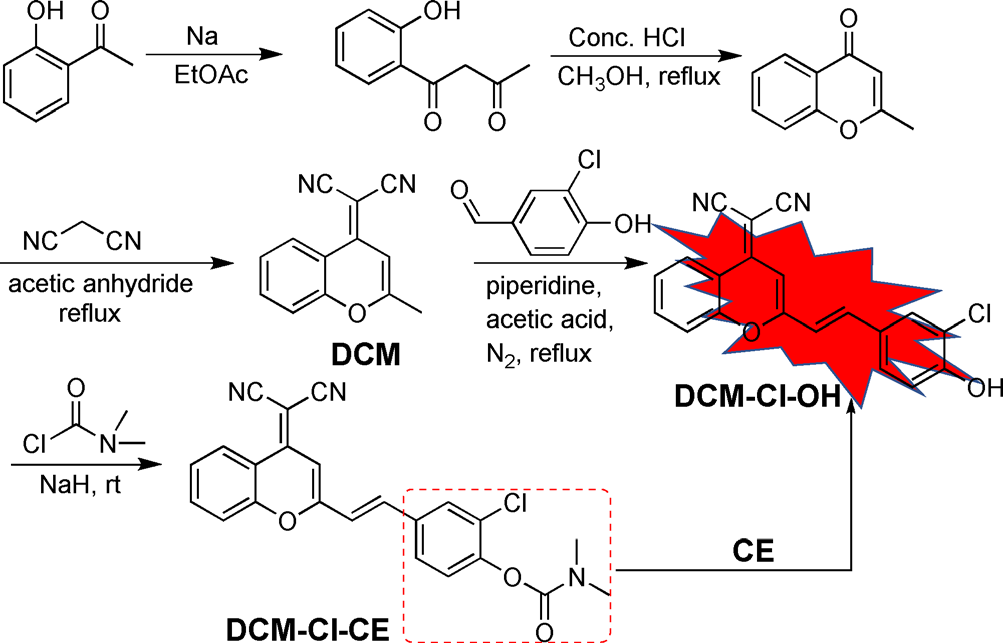
Scheme 2. Synthesis of the NIR TP fluorescent probe (DCM-Cl-CE) for CE and its reaction mechanism with CE.
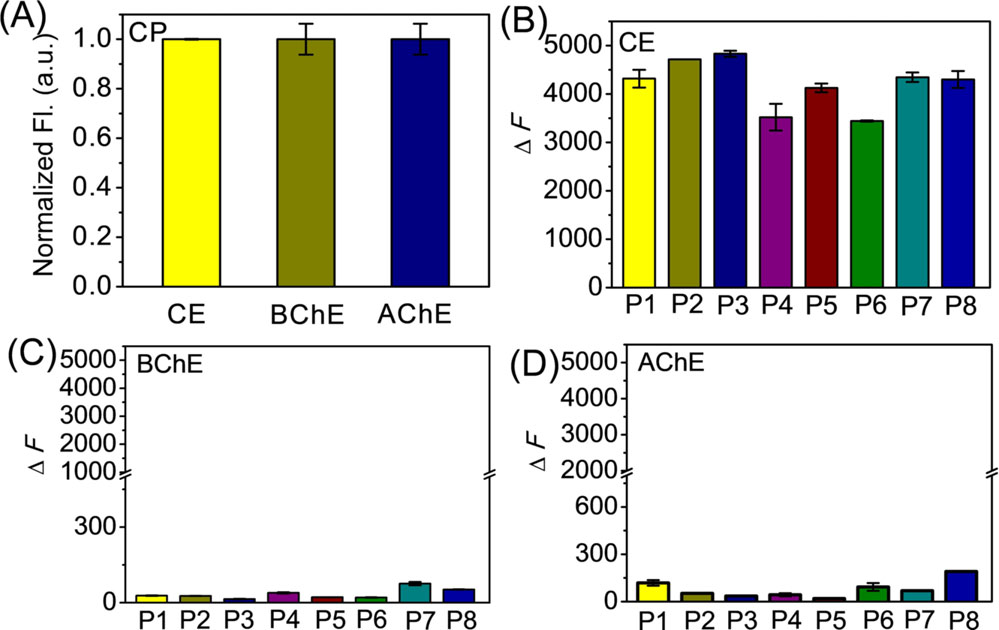
Figure 1. (A) Normalized fluorescence intensity of CP (5 μM) reacting with CE, BChE and AChE (1 U/mL) for 0.5 h at 37 oC in PBS buffer (pH 7.4), respectively. Fluorescence response of P1-P8 (5 μM) toward (B) CE (1 U/mL), (C) BChE (1 U/mL) and (D) AChE (1 U/mL) for 5 h at 37 oC in PBS buffer (pH 7.4), respectively. DF is the fluorescence intensity difference after and before the reaction. The results are expressed as the mean ± SD (n = 3). λex/em = 550/582 nm.
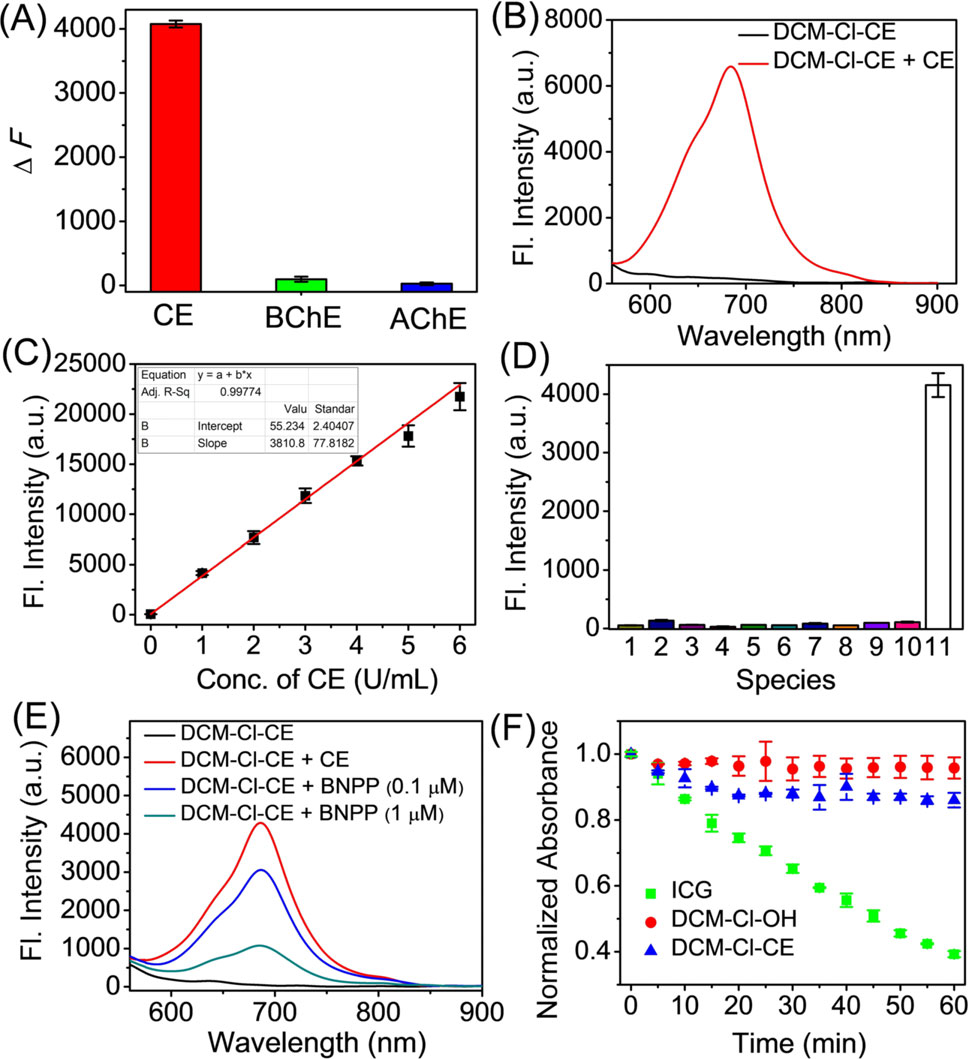
Figure 2. In vitro properties of DCM-Cl-CE. (A) Fluorescence response of DCM-Cl-CE toward CE, BChE and AChE (1 U/mL). (B) Fluorescence spectra of DCM-Cl-CE (5 mM) in the absence and presence of CE (1 U/mL). (C) Linear relationship between the fluorescence intensity and CE concentration (0-6 U/mL) for 5 h at 37 oC. (D) Fluorescence response of DCM-Cl-CE (5 μM) to various enzymes, including (1) the blank; (2) b-glucosidases (10 U/mL); (3) xanthine oxidase (10 mU/mL); (4) tyrosinase (10 U/mL); (5) ALP (10 U/mL); (6) MAO-A (10 μg/mL); (7) MAO-B (10 μg/mL); (8) trypsin (10 μg/mL); (9) HSA (10 μM); (10) BSA (10 μM) and (11) CE (1 U/mL). (E) Inhibitory activity of DCM-Cl-CE against BNPP under different conditions. (F) Photostability of DCM-Cl-CE, DCM-Cl-OH and ICG in PBS detected via absorbance spectra. The samples (all at 5 μM) were continuously irradiated by a light source (25 mW/cm2).
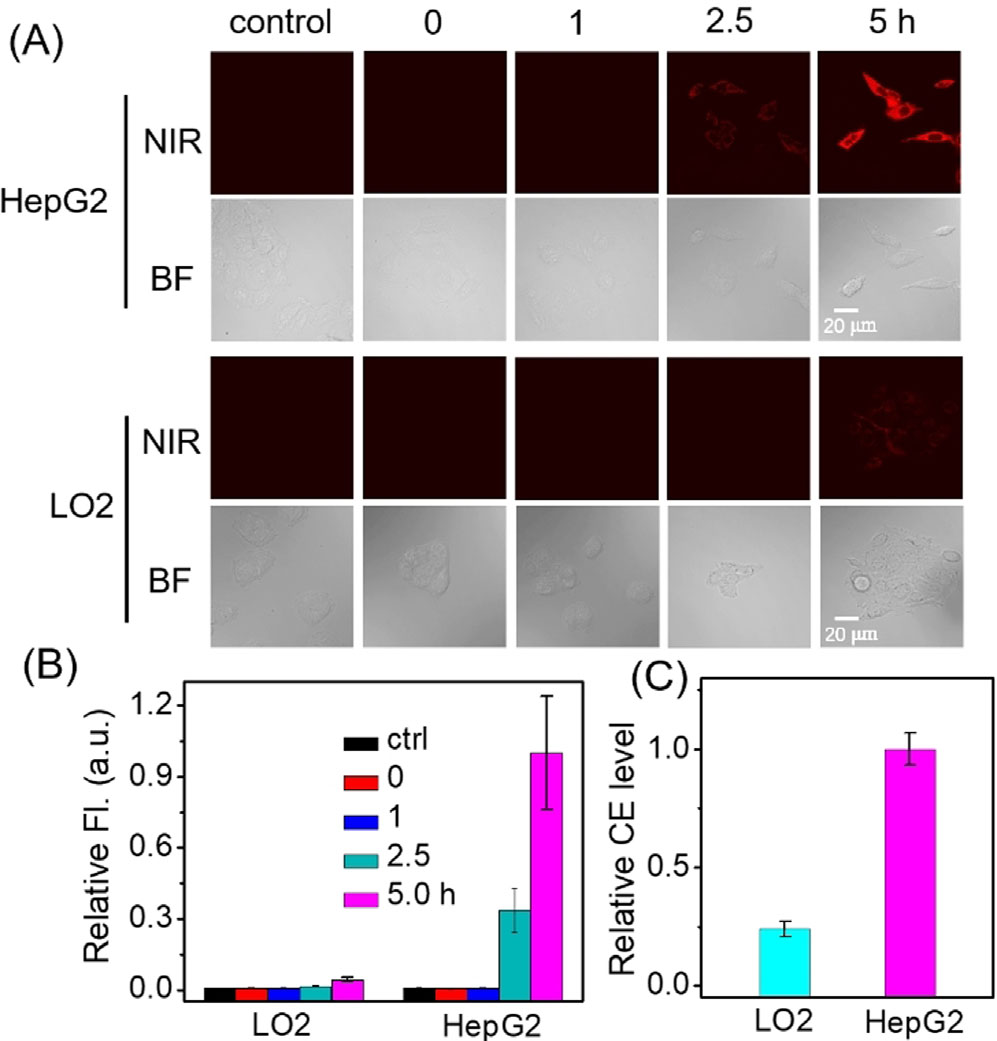
Figure 3. Comparison of CE levels in human liver cancer cells (HepG2 cells) and human normal liver cells (LO2 cells). (A) One-photon fluorescence imaging of DCM-Cl-CE in HepG2 and LO2 cells at different time points (0, 1, 2.5 and 5 h). The control group: fluorescence imaging of cells without probe. NIR: near-infrared emission channel; BF: bright field channel. (B) Relative fluorescence intensity in panel (A). (C) Analyses of CE levels by commercial kit in HepG2 and LO2 cells. (λex = 540 nm and λem = 650-750 nm). Scale bar: 20 μm.
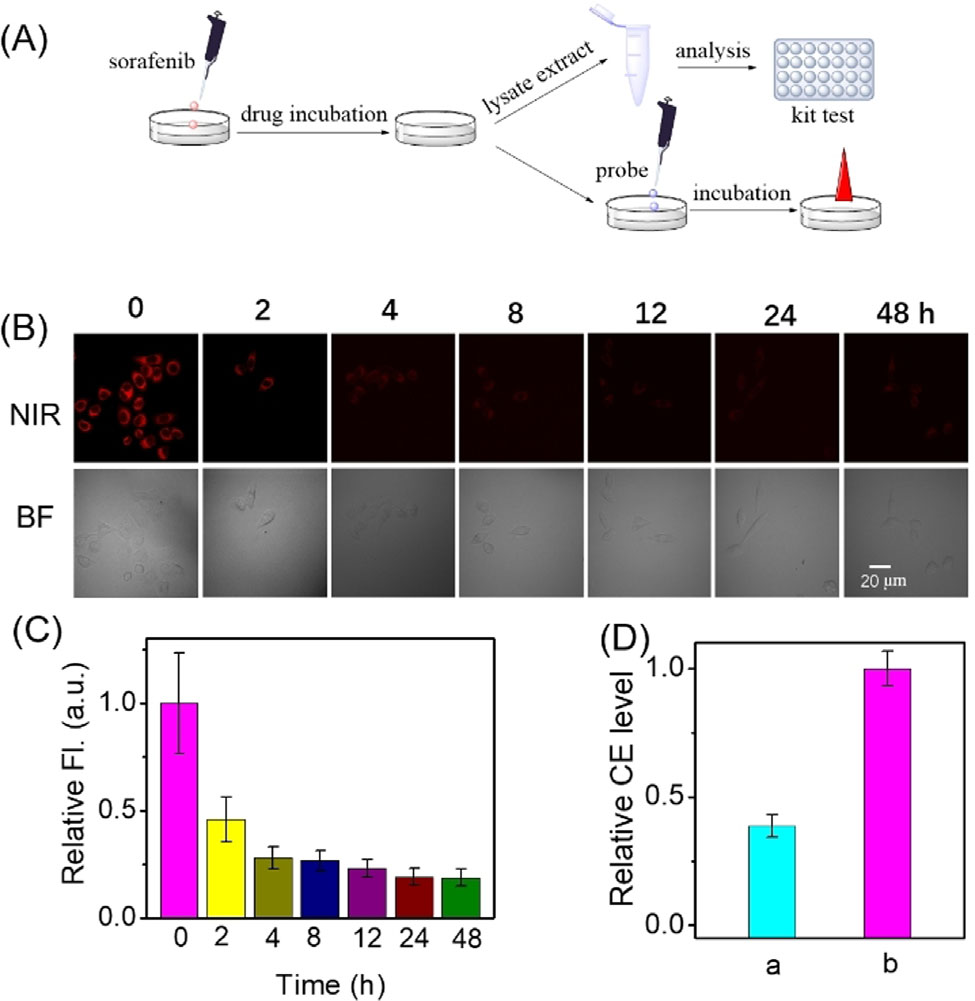
Figure 4. Visualization of CE activity in HepG2 cells treated with an anti-liver-cancer drug (sorafenib) using TP fluorescence imaging. (A) Schematic illustration of DCM-Cl-CE imaging CE activity in HepG2 cells treated with sorafenib and lysate extraction for analysis of CE levels. (B) TP confocal fluorescence imaging for CE activity in HepG2 cells after treatment with sorafenib (10 μM) for different times (0, 2, 4, 8, 12, 24 and 48 h) and then incubation with DCM-Cl-CE. (C) Relative fluorescence intensity in panel (B). (D) Analyses of CE levels in HepG2 cells with (a) sorafenib for 12 h or without (b) sorafenib via a commercial kit. λex = 830 nm and λem = 650-750 nm. Scale bar: 20 μm.

Figure 5. Visualization of imaging the conditions at the orthotopic liver cancer mouse model treated with the anti-liver cancer drug. (A) Time-dependent fluorescence imaging of CE activity in the subcutaneous HepG2-xenografted tumor-bearing mouse model was obtained at different time points (0, 0.5, 1.5, 2.5 and 5 h) by intratumoral injection of DCM-Cl-CE (10 μM). Red dotted circles indicate the tumor site. (B) Schematic illustration of DCM-Cl-CE imaging CE activity in the mouse treated with anticancer drug (sorafenib). (C) Timeline for the development of mouse model treated with sorafenib and bimodal imaging. (D) Imaging CE activity in orthotopic tumor-bearing mice treated with sorafenib by intravenous injection for different times (0, 7, 14, 21 and 28 days), followed by intravenous injection of DCM-Cl-CE (10 μM, 100 μL). (E) 2D ex vivo imaging of CE in separated organs (heart, liver, spleen, lung, and kidney) sacrificed from mice in panel (D). (F) Fluorescence intensity of the images in the panel (E). Red dotted circles indicate the tumor site. (G) Hematoxylin and eosin (H&E) staining of liver cancer tissue; Masson’s staining of liver cancer tissues; regional terminal deoxynucleotidyl transferase dUTP nick end labeling (TUNEL) staining of the liver cancer tissues. (H) 3D in vivo imaging of CE activity in the orthotopic liver cancer mouse model pretreated with sorafenib for 0 day, and then treated with DCM-Cl-CE (10 μM, 100 μL) for 5 h by intravenous injection. 3D reconstruction of fluorescence molecular tomographic (FMT) imaging of CE activity from coronal, sagittal, and transverse views. (λex = 540 nm and λem = 650-750 nm).
Conclusion
In summary, we have proposed dimethyl carbamate as a specific recognition moiety for CE activity, which was combined with a substituted self-immolative linker to develop a series of compounds (P1-P8) for screening the best substrate for CE activity. Based on the best recognition moiety of P3, a NIR TP fluorogenic probe (DCM-Cl-CE) was prepared for in vivo imaging of CE activity that can also effectively eliminate the interference from other hydrolyses. This probe displayed high sensitivity, selectivity, stability, and pH independence. Importantly, this probe has proven to image the difference in CE activity between HepG2 and LO2 cells, and successfully monitor changes in CE activity in HepG2 cells treated with anticancer drugs, making it applicable to indicate for the evaluation of drug treatment of HCC in vivo. With condition changing at different time points post-treatment in the mice model bearing orthotopic liver tumor (i.e., mice under different conditions), a positive correlation may be established between the fluorescence intensity of DCM-Cl-CE in vivo and continuous tumor apoptosis, indicating DCM-Cl-CE can be used to evaluate the condition of HCC chemotherapy. Moreover, for the first time, the CE activity in the tumor site with a high-resolution 3D view was visualized, allowing for possible image-guided diagnosis and surgical resection of HCC in the future. Considering the high selectivity and sensitivity, stabilities, and biocompatibility, we believe this enzyme-activated NIR TP fluorescent probe will be provided as an effective tool for in vivo and in situ monitoring the condition of the liver cancer and evaluations of drug treatments.
https://wap.sciencenet.cn/blog-2438823-1291545.html
上一篇:Development bioorthogonal SERS imaging probes
下一篇:Near-infrared theranostic fluorescent probe for lung cancer
全部作者的其他最新博文
- • Triphenylamine-AIE Materials for Cancer Theranostics
- • Fluorescent Probe forRatiometric Monitoring of Peroxynitrite
- • Fluorescence Probe for Pathological Stages of Wound Healing
- • Macrophage M2 polarization to neurological damage
- • SERS-RCA biosensor for profiling dual miRNAs
- • a glutathione-activated near-infrared fluorescent probe